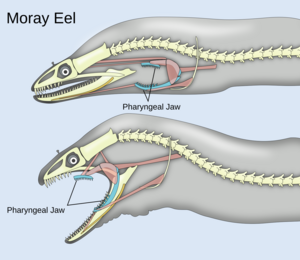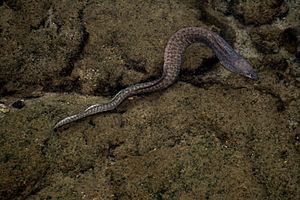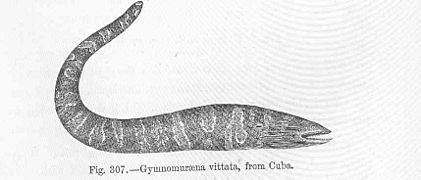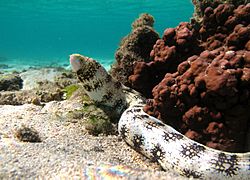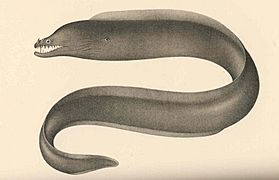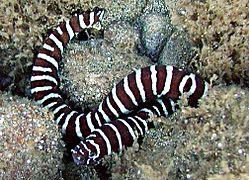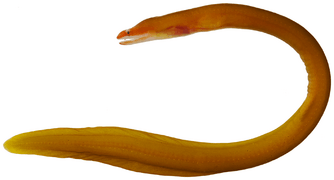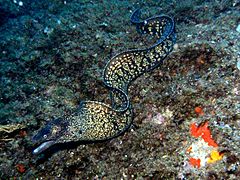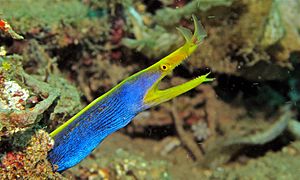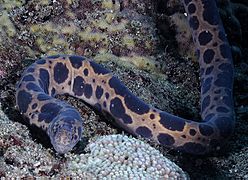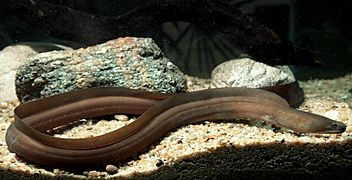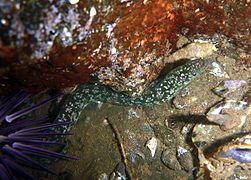Moray eel facts for kids
Quick facts for kids Moray eel |
|
|---|---|
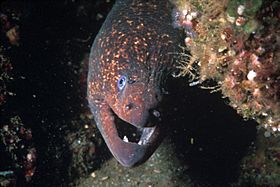 |
|
| Scientific classification | |
| Kingdom: | |
| Phylum: | |
| Class: | |
| Order: | |
| Family: |
Muraenidae
|
Moray eels are a type of eel that look a bit like snakes. Their scientific name is Muraenidae. You can find moray eels all over the world, especially in warm, tropical waters. There are over 200 different kinds (called species) of moray eels, grouped into 15 main types (called genera).
Most moray eels grow to be about 1.5 meters (5 feet) long. But the biggest one, the Slender giant moray, can reach an amazing 4 meters (13 feet) in length! Moray eels love to live in coral reefs and rocky areas. They often hide in deep cracks and holes in the rocks, sometimes as deep as 200 meters (650 feet) underwater.
Moray eels are carnivores, which means they eat other animals. They mostly hunt other fish, octopuses, squid, and crabs or shrimp. They have very sharp teeth for catching their prey. Some of their natural enemies include Groupers, other moray eels, and Barracudas.
Contents
Amazing Moray Eel Body Features
Moray eels have a unique body shape that helps them live in rocky reefs.
Fins and Eyes
The fin on their back (called the dorsal fin) starts right behind their head and goes all the way along their back. It connects smoothly with the fins near their tail (the caudal fin) and underneath (the anal fin). Most moray eels don't have the fins that stick out from the sides (like pectoral fins) or underneath (like pelvic fins). This makes them look even more like snakes!
Their eyes are quite small, so they don't rely on sight much. Instead, moray eels have an amazing sense of smell. They use their powerful noses to find prey while waiting hidden in their rocky homes.
Teeth and Skin
Moray eels have wide jaws and a snout that sticks out. Most of them have large, sharp teeth that help them grab and tear their slippery prey. However, some species, like the snowflake moray and zebra moray, eat crabs and other animals with hard shells. These eels have blunt, molar-like teeth that are perfect for crushing shells.
Morays have smooth skin without scales, and it's covered in a special protective mucus. In some types of moray eels, this mucus can even be a bit toxic. Their skin is much thicker than other eels, and they produce a lot of mucus. This helps sand stick to the walls of their burrows, making their homes stronger and more permanent.
Their gills, which they use to breathe underwater, are small and round. They are located far back on their sides. Because of this, moray eels often keep their mouths slightly open to help water flow over their gills and allow them to breathe.
How Moray Eels Use Their Jaws
Unlike most fish, moray eels can't use suction (like a vacuum cleaner) to pull food into their mouths. Instead, they have a special trick: a second set of jaws! These are called pharyngeal jaws. While most fish have these jaws to crush food, moray eels use them in a unique way.
When a moray eel catches prey, these pharyngeal jaws shoot forward from the back of their throat into their mouth. They grab the prey and then pull it back down into the throat. Moray eels are the only animals known to use these inner jaws to actively catch and move their food like this!
Their main mouth opening also stretches far back into their head. When they lunge and bite, water flows out the back of their mouth. This helps them attack quickly without creating waves that might push their prey away. Some moray eels, like the California moray, even have teeth on the roof of their mouth that can fold down. This prevents the teeth from breaking and helps them keep a grip on their prey as it moves down their throat.
The shape of a moray eel's jaws and teeth tells us a lot about what they eat. Eels that eat hard-shelled animals, like the Zebra moray, have short, rounded jaws and molar-like teeth. Eels that eat fish have pointed jaws and longer teeth. These differences are also seen in their special pharyngeal jaws.
What Moray Eels Eat
Moray eels are skilled hunters. They mostly eat smaller fish, octopuses, squid, and crabs. Larger moray eels are often top predators in their ocean homes, meaning they are at the top of the food chain.
Hunting Together
Sometimes, a type of fish called a roving coral grouper will team up with a giant moray eel to hunt. The grouper shakes its head to invite the moray to join. This teamwork helps them catch prey that might be hiding in cracks and holes that the grouper can't reach.
Where Moray Eels Live
Most moray eels live in saltwater, never going into freshwater. However, a few species, like the Freshwater moray, can live in freshwater.
In the ocean, moray eels can be found in many different places. They live in shallow waters near the coast, on continental shelves, and even in deep parts of the ocean. They are found in both tropical (warm) and temperate (cooler) parts of the world. Most species prefer warm, tropical or subtropical waters, especially where there are reefs.
Within these warm ocean areas, moray eels often hide in shelters like dead coral reefs or rocky areas. They are less likely to live in areas with lots of live coral.
Moray Eel Families
There are about 202 known species of moray eels, which are grouped into 16 different genera. These genera are further divided into two main groups, called sub-families: Muraeninae and Uropterygiinae. You can tell them apart by where their fins are located.
- In the Muraeninae group, the dorsal fin (on their back) is near their gill slits and runs down their back. The anal fin (underneath) is behind their anus.
- In the Uropterygiinae group, both their dorsal and anal fins are located only at the very end of their tails.
Even with these differences, there are still many varieties within each sub-family. The group called Gymnothorax is the largest, containing more than half of all moray eel species!
Moray Eels and People
Moray Eels as Pets
Some types of moray eels are popular pets for people who have aquariums. This is because they are tough, can eat different kinds of food, don't get sick easily, and have interesting personalities. The most common ones kept as pets are the Snowflake moray, the Zebra moray, and the golden-tailed moray. Other species are harder to find and can be quite expensive.
Images for kids
See also
 In Spanish: Murénidos para niños
In Spanish: Murénidos para niños



